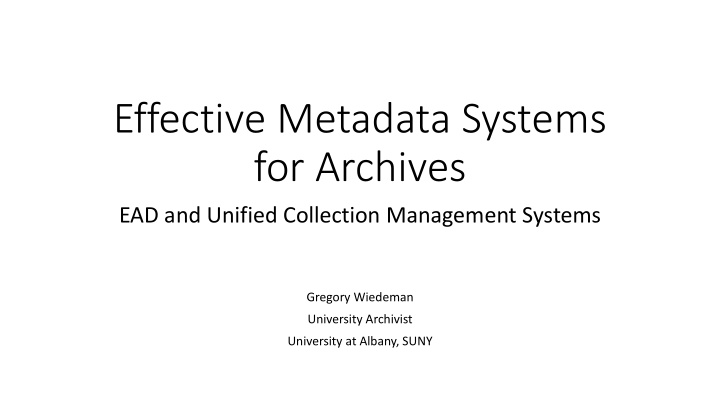



Effective Metadata Systems for Archives EAD and Unified Collection Management Systems Gregory Wiedeman University Archivist University at Albany, SUNY
Archival Metadata Systems • Paper Finding Aids • HTML Finding Aids • EAD records • Accession Databases • Unified Collection Management Systems • Archivist’s Toolkit • Archon • ArchivesSpace • Proprietary or Museum-focused systems
Functions of Archival Metadata Systems • Creation • Management • Editing & Modifying • Enable Administrative functions • Validation • Error-checking • Public Access • Aggregation • Future Migration Anne J. Gilliland-Swetland , “Popularizing the Finding Aid: Exploiting EAD to Enhance Online Discovery and Retrieval in Archival Information Systems by Diverse User Groups,” Journal of Internet Cataloging vol. 4, no. 3/4 (2001)
Local Habits Die Hard • Flexibility of finding aids • Archives unique, demand unique practices? • Local practices doesn’t mean bad decision -making • Unique practices come from unique local context • Problem was standardizing practices at the local level
Giving Data Structure • Paper finding aids have no structure • Not machine readable • Not able to have automated functionality • Structured data is unitized, has predefined rules • Necessary to develop tools • Use of XML to give structure to hierarchical archives metadata • EAD Standard
Problems with EAD, a Plural Standard • Allowance of mixed content and Unstructured Data • <physdesc> 12 cubic ft.</phydesc> • <langmaterial>This collection is in <language>English</language>.</langmaterial> • Failure to completely differentiate storage and display • Complains about public accessibility • Difficulty of validation • Inconsistencies in valid EAD files • Flexibility/Permissiveness • Many different ways to encode the same thing • Obstructs aggregation, migration • Makes overhauling the standard difficult • Hinders the development of modern online access tools
Problems with EAD, a Plural Standard • Allowance of mixed content and Unstructured Data • Influenced by TEI • Failure to completely differentiate storage and display • Web community still implementing concept • Difficulty of validation • Problem with XML as a whole • Flexibility/Permissiveness • Key to the wide use of EAD Elizabeth H. Dow, “Encoded Archival Description as a Halfway Technology,” Journal Of Archival Organization, 7 (2009)
Still advantages to EAD • Can be locally standardized with work • As close to digitally universal as you can get • Hierarchical structure matches archives metadata • New tools and cheap processing power to take advantage of XML • Raised the technological skills of archivists
Unified Collection Management Systems • Manage Administrative and Descriptive Metadata • Specific to archives • Graphical User Interfaces • Actually a way to avoid EAD • Rely on relational databases • Allows for more standardization • Can usually export to EAD
Unified Collection Management Systems • Archivist’s Toolkit (no longer supported) • Focus on back-end accessioning and creation of description • Archon (no longer supported) • Focus on front-end online access as well as the creation of description • AtoM (Access to Memory) • Front end online access system • ArchivesSpace • Goal to be complete end to end archival metadata system • SS code4lib article issue 9, 2010-03-22
Unified Collection Management Systems • ArchivesSpace • Archivist’s Toolkit backend • Archon public access • Multiple systems redundant? • Combine resources • Share development effort • Model is important, not software • One unified system
Unified Collection Management Systems • Can often be stricter than EAD • Can abrade with local practices • May need to make minor adaptions to your local workflow • Many arbitrary practices • Overall, wide use of these tools will standardize practices • Not always comfortable • Often promotes better metadata creation
The Persistence of EAD • Effective as Preservation Standard • Yet EAD is still at the center of complex workflows • Automated, not manual • EAD as a Metadata Dump • Unifying systems • Single Access point
Developing Better Descriptive Metadata at UAlbany • No Unified Collection Management Tool • Finishing full implementation of EAD • Inconsistent metadata • Manage metadata before migration
Using EADMachine to Create Consistent EAD http://github.com/gwiedeman/EADMachine
Python Scripts to Manage EAD • Unique ID System • Remove special characters • Standardize encoding • Remove mixed content when possible • Automate changes for digital objects • Rule based-validation • Separate public access system http://github.com/gwiedeman/EAD_Tools
Modular Metadata System Design • Multiple systems • Move to ArchivesSpace for accession system • Would need effort to migrate anyway • Maintain separate public access system • Possible continue to use EADMachine for now
Consistency, Consistency, Consistency • Inconsistent application of tools undermines there use • Doesn’t matter how good the tool is • Need to focus on use of tools, than functionality of tools • Consistency of Metadata, not tools • Do we really need one, single unified tool? • Benefits of shared resources?
Effective Metadata Systems for Archives EAD and Unified Collection Management Systems Gregory Wiedeman University Archivist University at Albany, SUNY
Recommend
More recommend